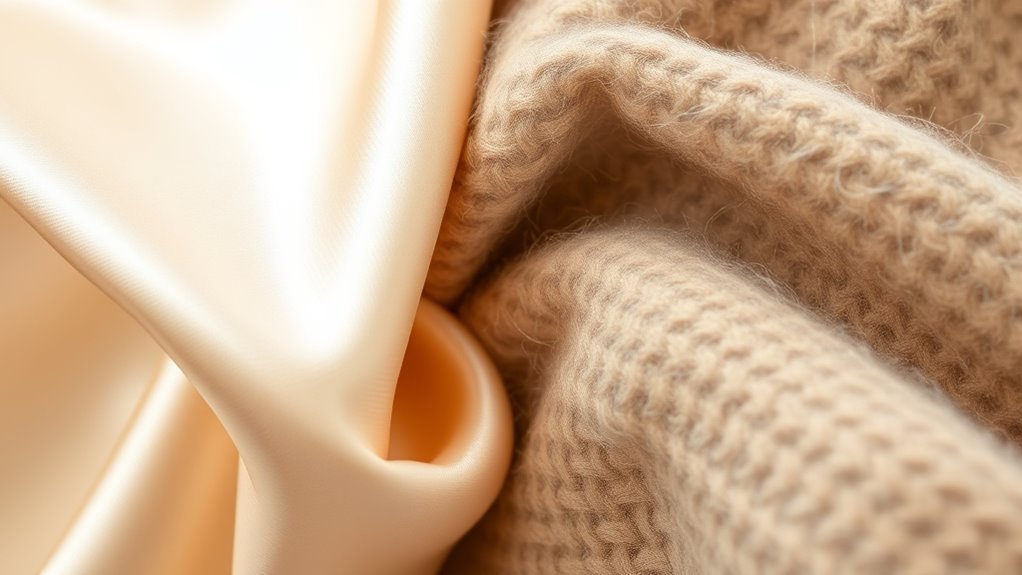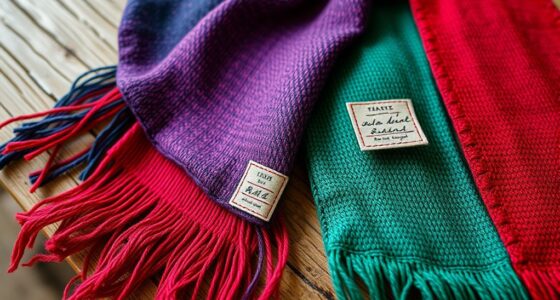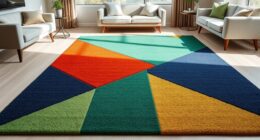Wool-silk blends are worth the premium if you value luxury, durability, and a refined texture. They offer a perfect balance of softness, warmth, and natural sheen, making them ideal for versatile, stylish garments. While their higher cost reflects quality craftsmanship, they provide long-lasting comfort and elegance that pure fibers might not match. To discover if this luxurious fabric suits your needs and how to care for it, keep exploring the details.
Key Takeaways
- Wool-silk blends offer a luxurious feel with enhanced durability, justifying their higher price compared to pure wool or silk.
- Their superior comfort and temperature regulation make them ideal for versatile, year-round wear, providing good value.
- The subtle sheen and elegant appearance elevate garments, making them a worthwhile investment for luxury or formal fashion.
- Advanced manufacturing and high-quality fibers contribute to the premium cost but ensure long-lasting, refined fabrics.
- They provide an excellent balance of softness, resilience, and affordability, making them a smart choice for those seeking luxury without the full silk price.
What Are Wool‑Silk Blends Made Of?
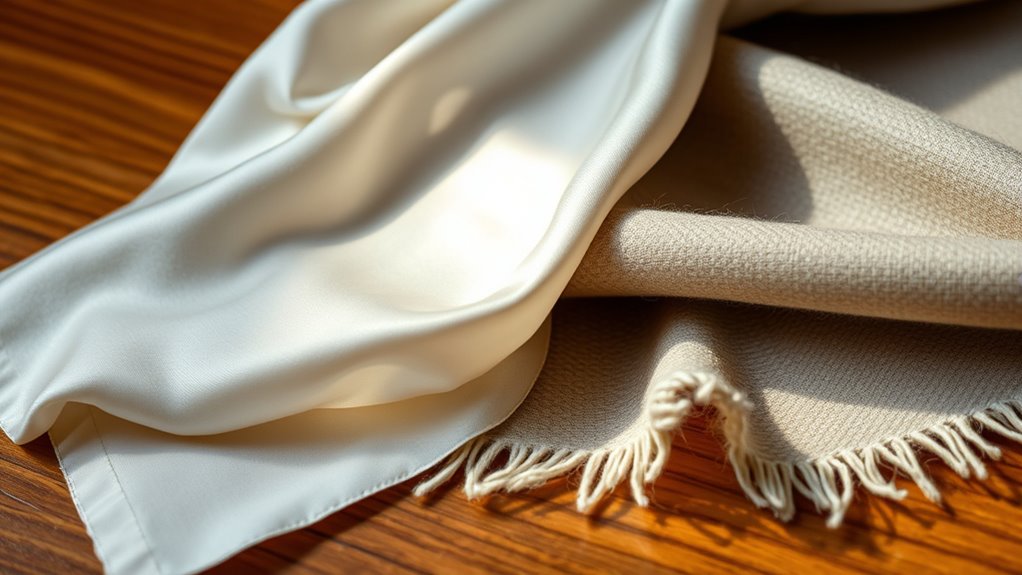
Wool-silk blends are made by combining natural fibers from sheep and silkworms to create a luxurious and durable fabric. The fiber composition typically includes varying ratios of wool and silk, depending on the desired qualities. Wool provides warmth, elasticity, and moisture-wicking properties, while silk adds luster, softness, and strength. The manufacturing processes involve blending the fibers during spinning, ensuring even distribution for a consistent texture. Wool fibers are usually carded and spun first, followed by the integration of silk fibers through blending or filament mixing. This careful process results in a fabric that balances the best features of both fibers, producing a material that’s both elegant and resilient. The specific fiber composition and manufacturing techniques directly influence the final fabric’s appearance and performance. Additionally, understanding the fiber blending process can help consumers appreciate the craftsmanship behind these luxurious textiles, as it requires precise control to achieve the desired fabric qualities. Moreover, fiber blending techniques are crucial in determining the final texture and durability of the fabric, making it a key aspect of textile craftsmanship. Proper quality control during production ensures consistency and high standards in the finished textiles.
Key Characteristics and Textural Qualities
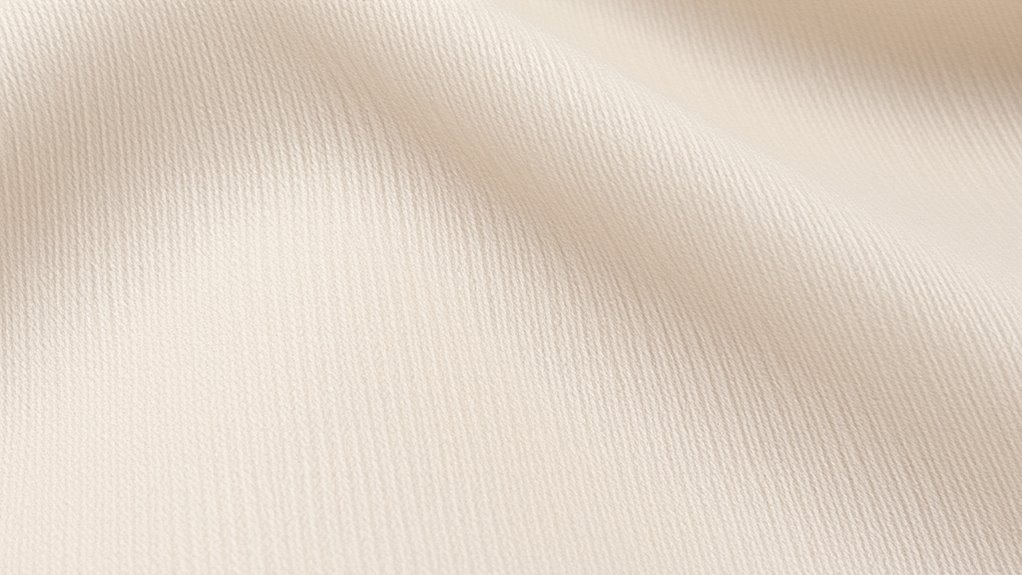
The combination of wool and silk creates a fabric with distinctive key characteristics that appeal to both touch and appearance. You’ll notice a refined texture variation, where the softness of silk complements the warmth and resilience of wool. This blend offers a smooth, luxurious feel against your skin, yet retains enough substance for durability. The aesthetic appeal is notable, with a subtle sheen from silk that enhances the fabric’s elegance. The tactile experience balances plushness with a slightly crisp quality, making it versatile for various garments. Overall, wool-silk blends deliver a unique combination of tactile richness and visual sophistication, elevating your clothing with a refined, luxurious character. This harmony of textures guarantees your piece stands out with both comfort and style. Additionally, understanding fiber technology can help you appreciate how these materials are processed to achieve such exceptional qualities. Incorporating textile innovation can further enhance the durability and appearance of wool-silk fabrics, ensuring they remain luxurious over time. Moreover, developing creative practices in textile design can inspire new ways to optimize the functionality and aesthetics of these blends, including exploring advanced weaving techniques for improved fabric performance. Exploring innovative dyeing methods can also contribute to the vibrancy and longevity of the fabric’s appearance.
Benefits of Combining Wool and Silk
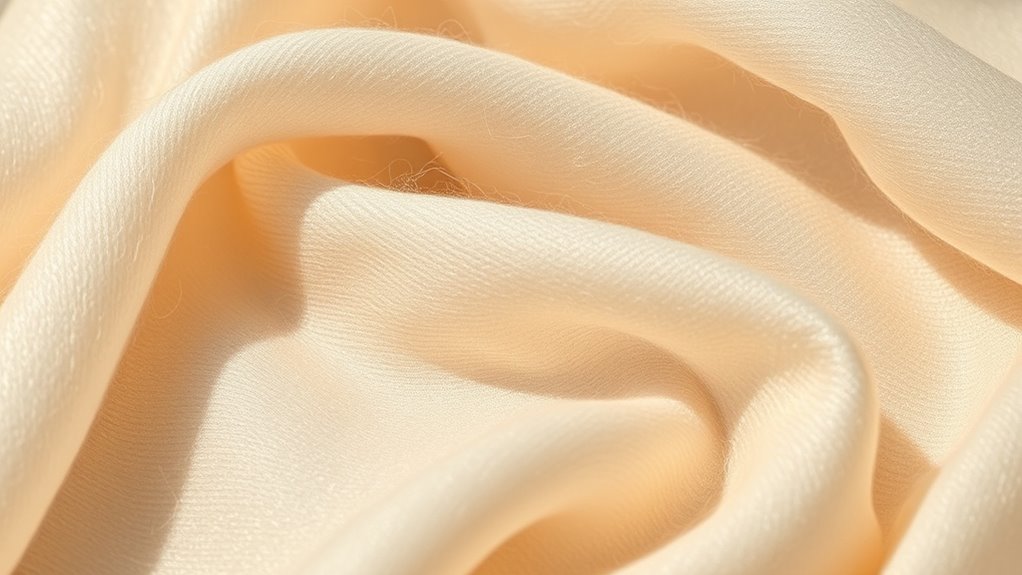
When you choose wool-silk blends, you’ll notice an immediate boost in comfort and softness that feels luxurious against your skin. These fabrics also offer better temperature regulation, keeping you warm in winter and cool in summer. Plus, their elegant appearance and feel add a sophisticated touch to any wardrobe.
Enhanced Comfort and Softness
Combining wool and silk creates fabrics that feel exceptionally soft and comfortable against your skin. This fiber blending results in a luxurious texture that enhances your comfort, making garments feel gentle and smooth. Silk’s smoothness integrates seamlessly with wool’s natural elasticity, providing a plush sensation without sacrificing durability. The blend’s fabric durability ensures that the softness lasts over time, resisting wear and maintaining its plush feel through repeated use and washing. You’ll notice an immediate difference in how the fabric drapes against your body, offering a cozy, yet refined experience. This combination allows you to enjoy softness without compromising on strength or longevity, making wool-silk blends an excellent choice for those seeking both comfort and resilience in their clothing or accessories. Additionally, understanding fabric properties can help manufacturers optimize production processes and ensure consistent quality in these delicate fabrics, especially when managing complex fabric blends and maintaining high standards. Appreciating the fiber composition helps in selecting the right care methods to preserve the luxurious feel over time. Furthermore, considering textile innovation can lead to the development of even more refined and durable wool-silk products for discerning consumers.
Superior Temperature Regulation
Wool-silk blends not only feel luxurious but also excel at regulating body temperature. Wool’s natural insulation keeps you warm in cold weather, while silk’s breathable fibers help cool you down when it’s hot. This dynamic balance makes these blends ideal for year-round wear. Because both fibers can be sourced sustainably, they support eco-friendly practices and reduce environmental impact. Modern dyeing techniques enhance the fabric’s coloration without compromising its natural properties, ensuring durability and vibrant hues. The combination allows heat to transfer efficiently, preventing overheating or chilling. As a result, you stay comfortable regardless of fluctuating temperatures. This smart synergy offers a practical, eco-conscious way to enjoy clothing that adapts seamlessly to your body’s needs, making wool-silk blends a smart investment for all seasons. Environmental considerations play a key role in choosing sustainable fibers, further emphasizing the eco-friendly benefits. Additionally, the moisture-wicking properties of both fibers help maintain dryness and comfort throughout the day. Incorporating space and organization techniques into your wardrobe management can help maintain these high-quality garments and extend their lifespan.
Elegant Appearance and Feel
The blend of wool and silk creates a fabric that exudes sophistication and offers a luxurious tactile experience. This combination provides a rich texture variety, blending the softness of silk with the subtle warmth of wool. You’ll notice a refined appearance that elevates any wardrobe. The fabric’s natural sheen enhances its elegance, making it suitable for both formal and casual wear. With a wide array of color options, you can choose shades that complement your style perfectly. The silk adds a smooth, lustrous surface, while the wool offers depth and structure. Together, they create a fabric that feels as impressive as it looks, delivering a sense of luxury and refinement with every touch. Additionally, the fabric blend can offer improved durability and moisture-wicking properties, enhancing its functionality along with its aesthetic appeal.
Common Uses and Garment Types
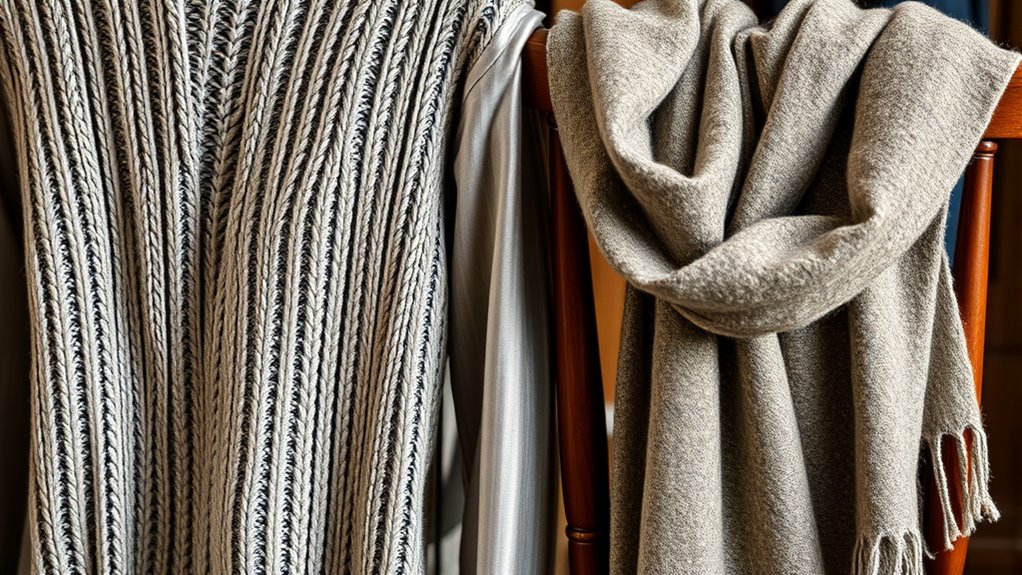
Wool-silk blends are popular for creating versatile clothing items you can wear in many settings. They’re often used in luxury fashion pieces that add elegance and comfort to your wardrobe. Whether for everyday wear or special occasions, these fabrics elevate your style effortlessly.
Versatile Clothing Items
Because of their natural softness and durability, wool-silk blends are popular in a variety of versatile clothing items. Their sustainable sourcing appeals to eco-conscious shoppers, while seasonal versatility makes them suitable year-round. You might find these fabrics in:
- Lightweight scarves that add elegance and comfort in winter and summer
- Classic blouses that shift seamlessly from office to evening wear
- Cozy sweaters perfect for layering during chilly months and breathable enough for warmer days
These garments often combine wool’s warmth with silk’s smooth feel, creating pieces that feel luxurious without sacrificing practicality. Whether you need an adaptable wardrobe staple or an eco-friendly option, wool-silk blends deliver stylish, sustainable choices for any season.
Luxury Fashion Pieces
Luxury fashion pieces often showcase the elegant qualities of wool-silk blends, elevating everyday garments into sophisticated statements. You’ll find these materials in high-end coats, evening dresses, and tailored suits that emphasize craftsmanship and refined textures. Because of their natural luster and durability, wool-silk blends create garments that feel luxurious and timeless. As you explore these pieces, consider how sustainable sourcing plays a role in their appeal, supporting fashion sustainability by reducing environmental impact. Designers increasingly prioritize eco-friendly practices, ensuring that luxury isn’t just about appearance but also ethics. When investing in these garments, you choose items that blend elegance with responsibility, making them not only stylish but also aligned with modern values of sustainability and mindful consumption.
Factors Influencing the Cost of Wool‑Silk Fabrics
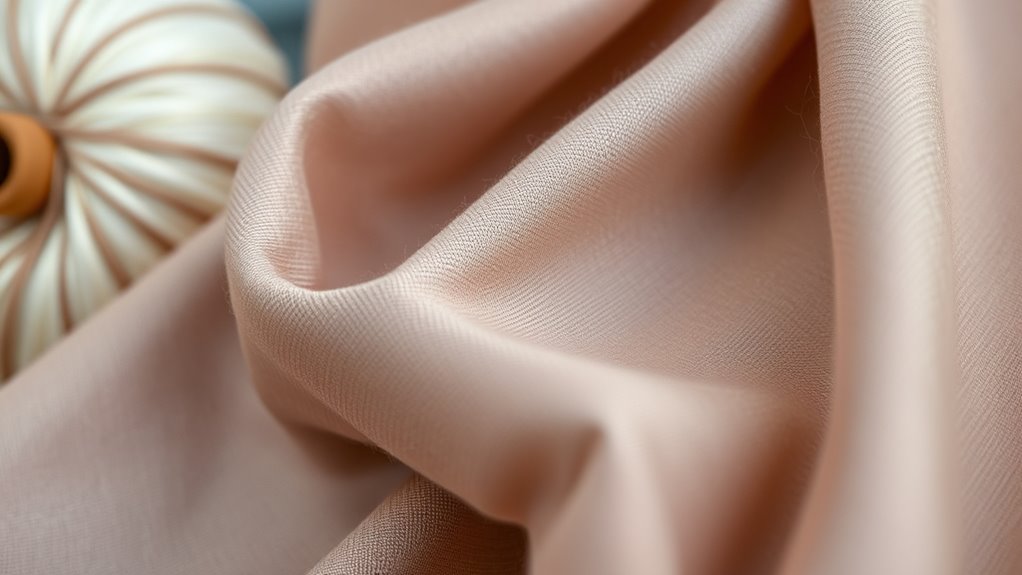
Several factors directly influence the cost of wool‑silk fabrics, shaping their market value and accessibility. One key aspect is fabric durability; higher-quality blends last longer and withstand wear, which often increases the price. Dyeing processes also impact costs, as intricate or specialized dye techniques can raise production expenses. Additionally, the complexity of the manufacturing process plays a role, including the blending technique and fabric fineness. Consider these points:
Fabric durability, dyeing techniques, and manufacturing complexity all influence wool‑silk fabric costs.
- Higher durability requires premium fibers and precise weaving
- Sophisticated dyeing methods add to production costs
- Finer, more delicate blends demand meticulous craftsmanship
These factors combine to determine the final price, making wool‑silk fabrics a significant investment based on their quality, process complexity, and longevity.
Comparing Wool‑Silk Blends to Pure Wool and Pure Silk
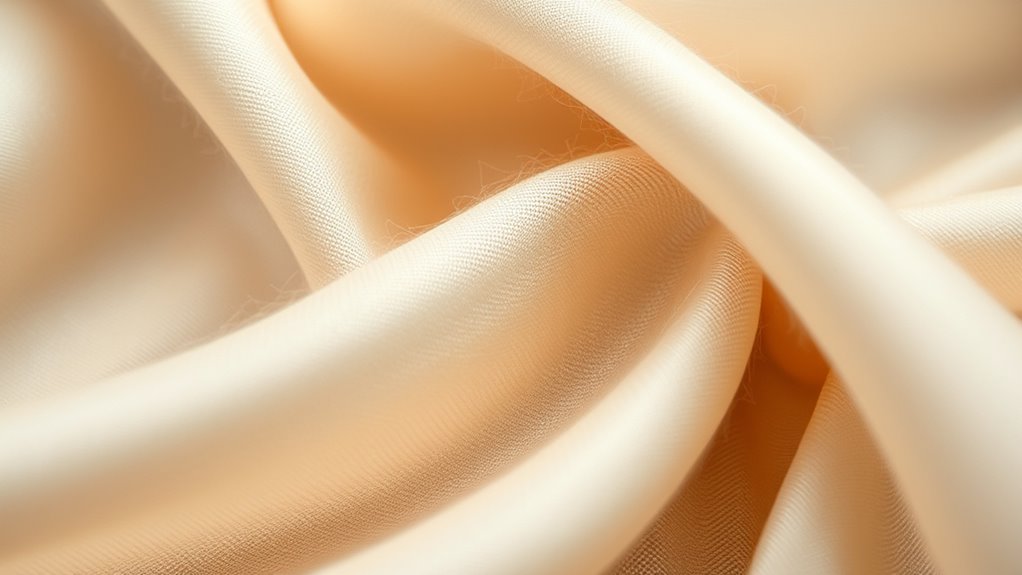
Wool-silk blends offer a middle ground between pure wool and pure silk, combining the best qualities of both fibers. They provide a softer, more luxurious feel than pure wool while maintaining durability and warmth. Compared to pure silk, these blends are often more affordable and easier to care for, making them appealing for luxury branding that emphasizes versatility. Fiber blending techniques allow manufacturers to optimize the strengths of each fiber, resulting in fabrics that balance sheen, texture, and resilience. While pure silk exudes elegance and exclusivity, wool-silk blends deliver a practical yet refined alternative. When you compare these options, consider how the blend’s unique properties match your style, comfort, and longevity preferences—each offering distinct advantages over the other.
Care and Maintenance Considerations
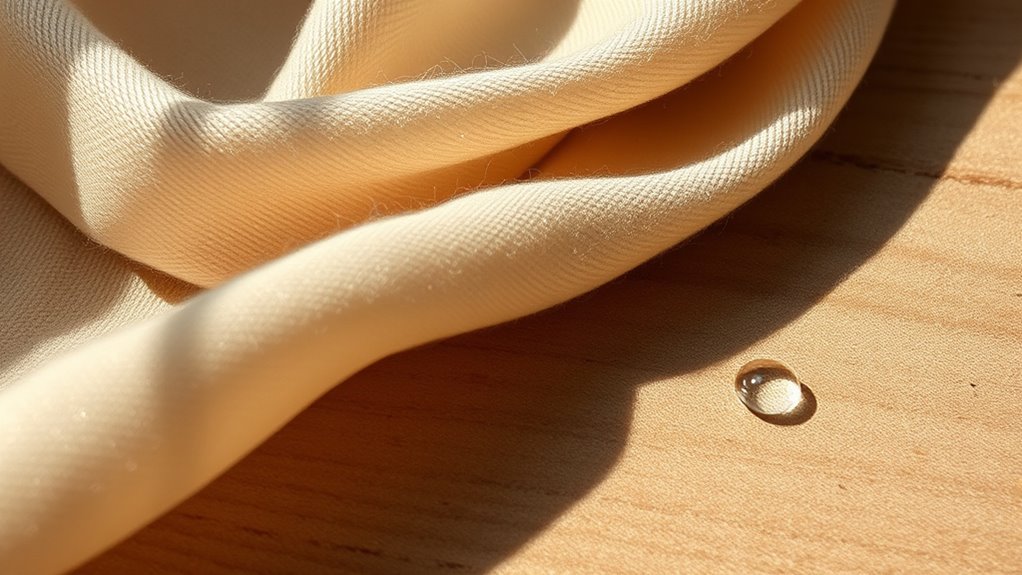
Caring for wool-silk blends requires understanding their unique properties to keep them looking and feeling their best. To maintain their elegance, follow these laundry tips: hand wash or use a gentle cycle with cold water, avoid wringing, and lay flat to dry. Proper storage solutions are essential—store folded in a breathable container, away from direct sunlight and moths. Keep your garments smooth by avoiding hanging heavy items, which can stretch the fibers. Use lavender sachets or cedar blocks in storage to deter pests. When cleaning, opt for mild detergents formulated for delicate fabrics. Always check care labels for specific instructions. By respecting these considerations, your wool-silk blends will retain their softness, sheen, and durability longer.
Is the Investment Justified? Weighing Value Against Price
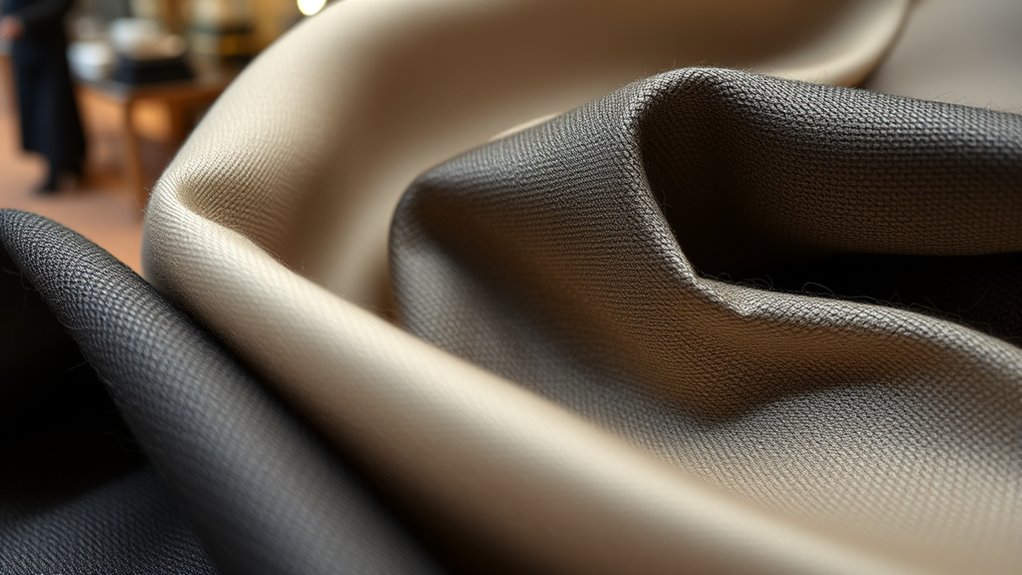
While wool-silk blends often come with a higher price tag, evaluating their true value depends on how well they meet your needs and expectations. The investment value hinges on qualities like durability, comfort, and appearance. If you prioritize a luxurious feel and long-lasting wear, the premium price may be justified. Consider the following factors:
| Feature | Benefit | Price Justification |
|---|---|---|
| Softness | Enhanced comfort and elegance | Higher cost reflects quality |
| Durability | Longer-lasting garments | Investment pays off over time |
| Appearance | Lustrous, refined finish | Premium materials used |
| Maintenance | Ease of care and longevity | Reduces long-term expenses |
Ultimately, weigh these factors against your budget to determine if the investment aligns with your expectations for value.
Frequently Asked Questions
How Do Wool-Silk Blends Compare in Durability to Other Fabrics?
Wool-silk blends tend to be quite durable, but they may not match pure wool or synthetic fabrics in longevity. You’ll notice good fabric elasticity, which helps resist wrinkles and maintain shape, but they can be prone to color fading over time if not cared for properly. Compared to other fabrics, wool-silk blends offer a balance of softness and strength, making them a worthwhile choice if you prioritize comfort and a refined look.
Are Wool-Silk Blends Environmentally Sustainable?
You might think wool-silk blends are eco-friendly, but their sustainability depends on sustainable sourcing and eco-friendly processing. If the wool and silk come from responsibly managed farms and factories use eco-conscious techniques, these fabrics can be quite sustainable. However, if not, they may have a larger environmental footprint. So, it’s essential to check the source and manufacturing methods to truly determine if wool-silk blends are environmentally sustainable.
Can Wool-Silk Blends Be Used for Activewear or Sportswear?
Wool-silk blends can definitely be used for activewear or sportswear. You’ll find that they offer excellent moisture management, keeping you dry during workouts, and their natural stretchability provides comfort and freedom of movement. The luxurious feel of silk combined with wool’s durability makes these blends ideal for active use. So, if you’re seeking stylish, functional gear, wool-silk blends are worth considering for your athletic wardrobe.
Do Wool-Silk Fabrics Cause Allergic Reactions?
Wool-silk fabrics are like a gentle whisper against your skin, but they can cause allergic reactions if you’re sensitive. You might experience fabric sensitivities such as itching or irritation. If you have allergies to wool or silk, it’s wise to test a small patch first. While many tolerate these blends well, always listen to your body and choose fabrics that keep you comfortable and itch-free.
How Do Wool-Silk Blends Behave in Different Climate Conditions?
Wool-silk blends adapt well to various climates, offering excellent climate adaptability. In cold weather, they insulate effectively, keeping you warm, while in warmer conditions, they breathe and wick moisture away, aiding moisture management. This dynamic fabric responds to temperature changes, making it versatile for different environments. You’ll find that their natural fibers work together to maintain comfort, whether you’re in a chilly or hot climate.
Conclusion
Ultimately, wool-silk blends are like a delicate dance between durability and elegance, offering a luxurious tapestry woven with practicality. While they come with a higher price tag, their unique harmony of softness and resilience makes them a worthwhile investment. If you’re seeking garments that feel like a gentle caress yet stand the test of time, these fabrics invite you to indulge in a symphony of nature’s finest fibers—truly a treasure worth the premium.
